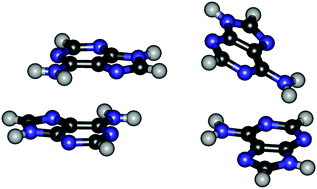We have performed reference quantum-chemical calculations for about 130 structures of adenine dimers in stacked conformations, with special attention given to dimers that are either vertically compressed (parallel structures) or contain close interatomic contacts (non-parallel structures). Such geometries are sampled during thermal fluctuations of nucleic acids and contribute to the local conformational variability of these systems. Their theoretical characterization requires a good description of interaction energies in the short-range repulsion region. The reference calculations have been performed with the CBS(T) method, i.e., MP2/CBS computations corrected for higher-order electron-correlation effects using the CCSD(T) method. These benchmark data have been used to examine the performance of the DFT-D, SCS(MI)-MP2, MP2.5, M06-2X and CBS(SCS-D) quantum-mechanical methods, and of the AMBER Cornell et al. force field. The present results, as well as those of our previous study on stacked uracil dimers, confirm that the force field severely exaggerates the repulsion at short intermolecular distances. This behavior complicates the use of the force field in scans of the stacking-energy dependence on local conformational parameters in nucleic acids. Compared against the previous results obtained in the uracil dimer study, the performance of DFT-D to describe stacking at short intermolecular distances has worsened, showing for the adenine dimers a larger exaggeration of the repulsion, especially for structures where the monomers are parallel to each other. Despite these deviations, the performance of DFT-D is still reasonably good and this method provides, for example, a relatively inexpensive way to monitor stacking energies along molecular dynamics trajectories. The best performers are the MP2.5, SCS(MI)-MP2, and CBS(SCS-D) methods. In addition, the energy profiles given by the SCS(MI)-MP2 and CBS(SCS-D) methods are the ones that most closely resemble the CBS(T) data. Interestingly, the performance of the SCS(MI)-MP2 method for stacked adenine dimers is better than for stacked uracil dimers, indicating that the quality of the description may vary with the nucleobase composition. Even though the SCS(MI)-MP2 method cannot match the speed of DFT-D, the results so far render it a promising tool to study intrinsic interactions in systems of moderate size. In general, for most applications all the QM methods tested here are of sufficient accuracy.


 Please wait while we load your content...
Please wait while we load your content...